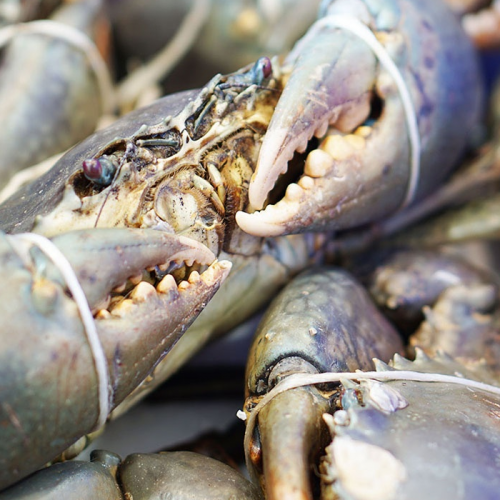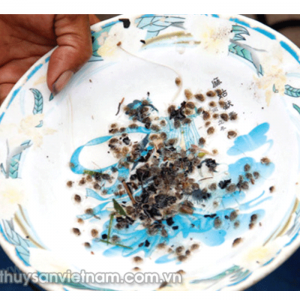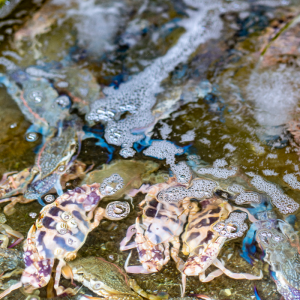
How Does Enzyme Activity Change When Crab Larvae Grow?
| Wed, 06 May 2020 - 08:06
In order to develop a proper diet, it is necessary to understand the activity of protein hydrolytic enzyme through the stages of developing crab larvae.
Sea crabs (Scylla paramamosain) are important cultured species in our country. With the characteristics of fast growth, high nutritional value, crab is a food with export value and a large consumption market, effectively from the crab farming models that have been bringing stable income to the region. At the seaside.
In order to provide farmers with good quality crab stocks and to reduce the pressure on wild-caught species, crab production is increasingly concerned and developed. However, the survival rate in artificial seed production is still low, usually from 5-7%. With current technology, the larvae mortality rate in metamorphic stages is still high, culminating in the Zoae (Z1-Z3) and from Zoae-5 (Z5) to Megalopa stages, which is a big challenge for larval rearing process. In addition to disease caused by Vibrio, the low survival rate in mud crab seed production has been attributed to inadequate seed production technology due to lack of knowledge about larval development and digestive physiology.
Importance of feed hydrolytic enzymes in crustaceans
Crustaceans often lack enzymes necessary for hydrolysis of food. A number of studies have shown the importance of fresh food as the first food for fish larvae and mollusks, using enzymes in food to improve digestion until the digestive system becomes complete development.
In order to successfully develop crab crab breeding technology, knowledge of the development of digestive enzymes is essential in the nutritional physiology and development of appropriate feed and feeding regimes necessary to meet meet the nutritional needs of crab larvae. However, studies on digestive enzyme characteristics of Scylla paramamosain crab larvae are very limited.
This study describes the characteristics of some protein hydrolyzate enzymes (trypsin, chymotrypsin, pepsin, protease) as a basis for the formulation of reasonable diets in larval rearing, contributing to improved survival rates. of sea crab larvae.
Protein hydrolytic activity changes as crab larvae develop
Healthy larvae were collected and treated by formol 200 ppm for 30 seconds before being placed in 3 nursery tanks, volume of 0.5m 3 , salinity 30 ‰, nursing density of 400 larvae / liter.
Crab larvae were fed with Artemia 6 times daily. The tank has a bottom siphone and changes water every 3 days, each time changing 25% of the water.
Check and maintain alkaline content at 100 - 120ppm NaHCO 3 . When the larvae were completely transferred to Zoae-4, they were collected and transferred to the 2m 3 composite tank , arranged at a density of about 50-70 larvae / liter. When the larvae moved to Megalope, proceed to place plastic mesh baskets for the larvae to cling and limit eating.
The activity of protease, trypsin, chymotrypsin and pepsin was analyzed during larval development from Zoae-1 to Crab-1. The results showed that during the larval development stage, the activity of the protein hydrolytic enzyme of sea crabs had a large variation in each stage, in which the activity of protease and pepsin enzymes increased gradually (from 3.85 to 19.1 U / mg protein and 1.69 to 8.32 U / mg protein) in all larval stages, while trypsin and chymotrypsin activity from Zoae-1 to Zoae-5 is very low (0.92 - 0.99 and 1.15 -0.85 U / mg protein), there are major changes in the stages of Zoae-5, Megalope and Crab.
In the Zoae-1 to Zoae-5 stage shows low activity of protein hydrolytic enzymes, to the Zoae-5, megalope stage, the enzyme activity is relatively complete, to the Megalope stage and to the metamorphosis to crab, Enzymes have a big change in finishing activity according to changes in morphology and feeding behavior of crabs.
These results indicate changes in the activity of protein hydrolytic enzymes during the development of mud crab larvae, from which to select suitable food sources in the nursery process to suit each development stage. , contributing to raising the survival rate in the nursery process.
Source: Tepbac






















